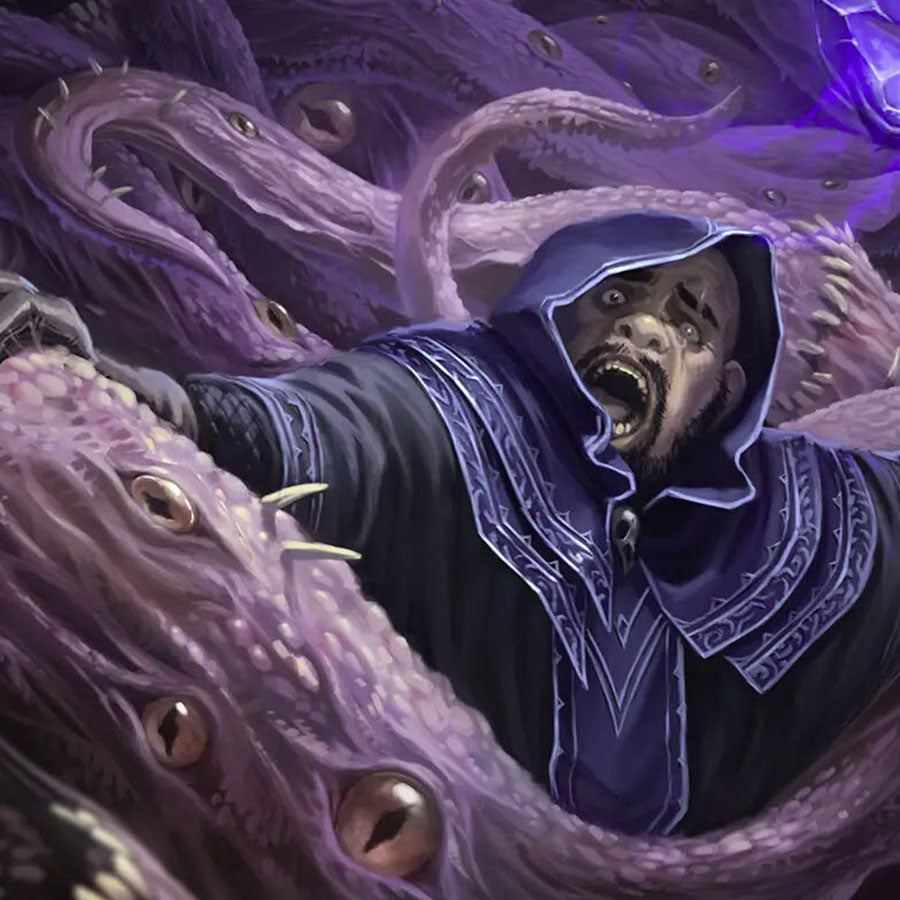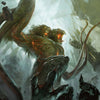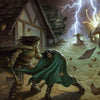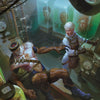Easy-to-Use 5e Insanity System

When I started running Curse of Strahd for my players, I wanted an insanity system I could use. Since it’s a module that focuses a lot on horror, having the risk of characters progressively going insane over the course of the adventure made sense.
So, I turned to the dungeon master guide, found the Sanity Score rules and the Madness tables…and was disappointed. Two of the madness tables there are far too punishing, almost making a character unplayable. And the third table is almost meaningless. And there is nothing in place for PROGRESSIVE insanity – that is, a way for a character to slowly descend into madness gaining mild negative effects at first but gradually having those effects get worse and worse.
And THUS we needed to homebrew a little something something. So, today I’ll be going over the insanity system that my team and I came up with.
This insanity system, by the way, is available in Sanity & Sabotage, the February 2022 issue of Lair Magazine.
Watch or listen to this article by clicking the video below.
The Insanity Level
In our system, a character’s insanity is tracked using a new Insanity Level mechanic. A character begins the game with an insanity level of 0 and then as they undergo traumatic events that insanity level increases. As their insanity level increases, they progress through three tiers of insanity.
Characters with insanity levels between 0 and 9 have Tier 1 Insanity; characters between 10 and 19 have Tier 2 Insanity; and characters between 20 and 39 have Tier 3 Insanity.
Furthermore, when a character undergoes a traumatic event, they also gain a flaw or negative effect, which is determined by a roll on the Insanity table that corresponds to their Insanity Tier.
The Insanity Tables
Each tier of insanity has its own table with flaws and negative effects that characters are afflicted with when they undergo a traumatic event that affects their sanity. And here’s a key mechanic: those negative effects get WORSE as the character becomes more insane. Now Tier 1 Insanity just gives a character flaws that they roleplay out. Such as “The character has endured threats, betrayals, and ambushes throughout their journey. They hold a deep-seated fear of anyone who is not a close friend, causing them to begin to draw their weapon whenever they meet a new acquaintance.” Such flaws wouldn’t necessarily affect game play too much, though it would certain lead to some interesting roleplaying. And that’s the point. The beginning stages of insanity should NOT be too punishing.
However, once a character progresses to Tier 2, they become afflicted with MECHANICAL drawbacks in the game. For instance, “The character has begun struggling with their nerves, making it difficult to stay still for any period of time or remain hidden. The character now has disadvantage on Dexterity (Stealth) and Dexterity (Sleigh of Hand) checks.” Now we have something that WILL affect game play at a higher level and be much more of a drawback to the character. It’s not DEBILITATING, but it’s not something to which you just shrug and say, “Whatever…”
Now, when a character progresses to insanity tier 3, things start to get much worse for them. For example, “The character now experiences intense fear when close to an enemy. Whenever the character begins a turn in melee range of an enemy, the character must make a DC 17 Wisdom saving throw. On a failure, the character is frightened of all enemies in melee range and must use its movement to get as far away from them as possible.” That’s no joke. A fighter or barbarian afflicted with that condition is going to have serious problems in the game. As it should be. The character’s mind is unraveling at Insanity Tier 3, and they are about to completely lose it. Unless they do something about it, of course.
If a character’s insanity level reaches 40 or above, they have a 50% chance of undergoing a permanent mental breakdown when a traumatic event happens. If they suffer this breakdown, they can no longer benefit form a short or long rest, cannot take any action except an unarmed attack, and spends their days wandering aimlessly and muttering about the terrors of the world.
Yes, that’s right, the character has become unplayable at that point. Which is why it might behoove players to do something about their character’s insanity before it gets too bad.
Treating Insanity
Characters can get treatment for their fraying minds and growing madness from priests or other specially trained NPCs. The D&D equivalent of shrinks. Once a suitable priest or psychiatrist is found, the character must pay an appropriate fee and spend one week undergoing treatment. Then their insanity level is reduced by a random amount determined by a die roll.
Now, in my games all characters take downtime activities after every major adventure and prior to leveling up. So, getting treatment for insanity thus becomes a potential downtime activity. And, Varis from my Curse of Strahd game has in fact gotten treatment for his insanity several times now.
How to Use the Insanity System
There are two ways I suggest using this insanity system. The first is the way I do it for my Curse of Strahd game: every time the characters undergo a traumatic event—yes, it’s up to the DM to determine what classifies as a traumatic event, though my players often opine on that—the characters all roll on the table that corresponds to their tier of insanity and gain a new flaw or negative effect.
Second, you could implement the Sanity Score system described on page 264 of the dungeon master’s guide. With it, a character gains a seventh ability score – Sanity – that functions similarly to the other six, Strength, Dexterity, etc. And then you use their Sanity score for sanity checks or sanity saving throws. Specifically, every time a character undergoes a traumatic event, they must make a Sanity saving throw with a DC determine by the dungeon master. The DC should correspond to how horrific the event was. And then if a character fails the saving throw, their insanity increases and they roll on an Insanity table to gain a new flaw or negative effect.
Finally, you could design your own insanity system and tables based on ours, or you could just use our Insanity System and save yourself the trouble. Now, we’ve included enough broll in this video that you could just take screenshots and basically get it for free. And if you want to do that, that’s cool by me.
Or you could avoid that hassle because, as I mentioned earlier, our Insanity System is available in the February 2022 issue of Lair Magazine, and in that same issue you will also get our Madness of the Deep Adventure Arc which uses the insanity system. The adventure arc consists of three fifth-edition compatible adventures designed for levels five, six, and seven, and features brand new aboleth variants and aboleth spawn. The issue also contains several stand-alone encounters featuring said new aboleth variants and spawn that you could drag and drop into your ongoing campaign. Oh, oh, and did I mention that Lair Magazine includes the DIGITAL MAPS for all the adventures and encounters? That’s right digital maps for running games online come included.
-
Posted in
Game Master How-To Articles







